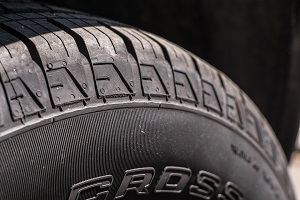What’s Inside Your Tires?
What Lies Beneath Your Tires?

The modern tire is a marvel of engineering and innovation, far removed from the simple air-filled rubber tubes of yesteryears. Decades of research and development by leading tire manufacturers have transformed these humble components into sophisticated structures capable of withstanding immense stress while delivering optimal performance.
Tread
The tread is the visible, patterned rubber layer on the outer surface of your tire. Its design varies depending on whether the tire is designed for passenger vehicles, trucks, or off-road applications. The tread pattern plays a crucial role in traction, handling, and overall durability.
Belts (or Belt System)
Directly beneath the tread lies the belt system, usually made of steel cords. These belts serve to stabilize the tread, enhancing the tire's ability to grip the road and extending its lifespan. They also help maintain the tire's shape under high-speed conditions.
Body Ply
One of the foundational elements of a tire is the body ply, positioned just below the steel belts. Composed of layers of polyester fabric bonded with rubber, the body ply provides structural integrity, allowing the tire to support the vehicle's weight while maintaining its form.
Bead
At the base of each side of the tire, you'll find the bead, a critical component made of reinforced steel wires encased in rubber. The bead ensures a tight seal between the tire and the wheel rim, preventing air leakage and maintaining proper inflation.
Inner Liner
The innermost layer of the tire is the inner liner, responsible for retaining air within the tire. Made of impermeable materials, this layer guarantees that no air escapes through the rubber, ensuring consistent tire pressure.
Sidewall
The sidewalls are the flexible rubber sections on either side of the tire. They not only protect the internal structure from external damage like potholes and curbs but also contribute to ride comfort and noise reduction.
Each part of the tire has evolved over time to enhance performance, safety, and longevity. Today's tires can easily last up to 100,000 miles, compared to the outdated bias-ply tires of the past, which typically lasted only around 20,000 miles.
Book your tire service appointment online today!
UV conformal adhesive is an adhesive that can cure quickly under ultraviolet irradiation. It is mainly used to protect electronic components from moisture, dust and chemical substances.It can be used for protection of circuit boards.
Â
Characteristics of UV curable conformal coating:
1.Fast curing: Under ultraviolet irradiation, it can be quickly cured in a short time to improve production efficiency.
Â
2.Good protective performance: It can effectively prevent moisture, dust and chemical substances from damaging electronic components and extend the service life of electronic equipment.
Â
3.High transparency: It has good transparency after curing and does not affect the appearance and marking of electronic components.
Â
4.High and low temperature resistance: It can still maintain stable performance in different temperature environments.
5.Environmental protection: generally does not contain harmful solvents and meets environmental protection requirements.
Â
Application
1. Consumer Electronics
- ​Devices: Smartphones, wearables, tablets, laptops, and IoT devices.
- ​Purpose: Protect PCBs from moisture, dust, and chemical exposure in compact, high-density designs.
- ​Advantage: Fast curing (<1 minute) supports high-volume production.
​2. Automotive Electronics
- ​Components: Engine control units (ECUs), sensors, infotainment systems, EV battery management systems (BMS), and ADAS modules.
- ​Purpose: Shield against temperature extremes, vibration, humidity, and automotive fluids (e.g., oils, fuels).
- ​Advantage: Low thermal stress prevents damage to heat-sensitive parts.
​3. Aerospace and Defense
- ​Applications: Avionics, radar systems, satellite electronics, and communication modules.
- ​Purpose: Ensure reliability in extreme environments (high altitude, radiation, thermal cycling).
- ​Advantage: Meets stringent MIL-STD and IPC standards for durability.
​4. Medical Devices
- ​Examples: Implantable devices, diagnostic equipment, wearable monitors, and surgical tools.
- ​Purpose: Protect against bodily fluids, sterilization processes (e.g., autoclaving), and biocompatibility requirements.
- ​Advantage: Low-VOC formulations comply with FDA and ISO 13485 standards.
​5. Industrial Electronics
- ​Applications: Motor drives, robotics, power supplies, and automation controllers.
- ​Purpose: Resist dust, chemicals, and humidity in harsh factory or outdoor environments.
- ​Advantage: High dielectric strength prevents short circuits in high-voltage systems.
​6. LED Lighting
- ​Use Cases: PCB protection in LED drivers, streetlights, and horticultural lighting systems.
- ​Purpose: Guard against thermal stress, humidity, and UV/IR exposure.
- ​Advantage: Transparent coatings maintain light output efficiency.
​7. Telecommunications
- ​Components: 5G infrastructure, base stations, routers, and fiber-optic modules.
- ​Purpose: Ensure signal integrity and protect against environmental corrosion.
- ​Advantage: Thin, uniform coatings minimize signal interference.
​8. Military and Ruggedized Systems
- ​Examples: Battlefield communication devices, unmanned vehicles, and missile guidance systems.
- ​Purpose: Enhance survivability under shock, vibration, and extreme temperatures.
- ​Advantage: Rapid field repairs using portable UV lamps.
​9. IoT and Smart Devices
- ​Applications: Smart home sensors, agricultural monitors, and asset-tracking systems.
- ​Purpose: Enable long-term reliability in diverse environmental conditions.
- ​Advantage: Selective coating reduces material waste in small-scale designs.
​10. Renewable Energy Systems
- ​Components: Solar inverters, wind turbine controllers, and battery storage systems.
- ​Purpose: Protect against outdoor exposure, temperature fluctuations, and salt spray.
- ​Advantage: UV resistance prevents yellowing or degradation over time.
Â
conformal coating,circuit board glue,ultraviolet curing,uv light adhesive, electronic glue,adhesive glue for electronics supplier
Dongguan Shuangzhan Industrial Co.,Ltd , https://www.lingwogroup.com
